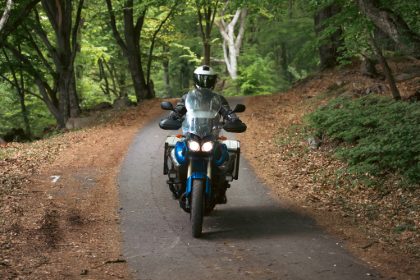OUR BLOG
Thinking of taking a solo motorcycle trip? Learn how to ride smart, stay safe, and enjoy every mile with tips from AED Marketing Inc. in Pasadena, TX. Let’s dive in!

Your Ultimate Guide to a Safe and Adventurous Solo Motorcycle Trip
There’s something special about riding alone. It’s freedom in its purest form. No schedules. No one to answer to. Just you, your bike, and the open road.
If you're gearing up for your first solo trip, you’re likely dreaming of the thrill. It’s an unbeatable feeling of independence.
But with that freedom comes responsibility. When you ride alone, you’re the one calling the shots, which means preparation and safety are key.
That’s where this guide comes in. We’ll walk you through everything you need to do to make your solo trip as safe as it is unforgettable. Let’s dive in!
Wherever your motorcycle takes you, keep it running at peak performance with AMSOIL. Restock your supplies online or call AED Marketing Inc. in Pasadena, TX, at (281) 507-8721 to meet your bike's needs.
1. Inspect Before You Ride: Pre-Trip Maintenance Checklist
Before you even turn the key, take the time for a thorough inspection. It’s one of the most important things you can do before heading out solo. Use this checklist:
-
Check oil and all fluid levels.
-
Inspect tire pressure and tread depth.
-
Test brakes, brake pads, and lights.
-
Check chain or belt tension.
-
Look over the battery condition.
-
Examine the fuel system for leaks or clogs.
Once everything looks good, take a quick ride around the neighborhood to ensure your bike feels and sounds right. Better to catch issues at home than on the highway.
2. Dress the Part: Gear Up for Safety and Comfort
Your riding gear is your first line of defense, so never hit the road without it. Always wear a DOT-approved helmet, armored jacket and pants, protective gloves, and sturdy riding boots.
To remain visible, opt for bright colors. Select high-visibility hues or reflective materials that stand out, whether during the day or night.
Long ride ahead? Pick ventilated gear for airflow and pack lightweight rain layers in case the skies open up.
3. Check the Skies: Know the Weather Forecast
Weather changes fast, especially on long routes. Always check the forecast for your full trip, not just your starting point.
If you see storms, extreme heat, or strong winds, adjust your plans. Being flexible can save you from dangerous conditions. Pack that rain gear, and when the weather hits, slow down and stay alert.
4. Be Seen, Stay Safe: Enhance Your Visibility
When you’re riding solo, you don’t have the visibility of a group. Make yourself stand out.
Here’s how:
-
Remember to wear high-vis gear.
-
Add reflective tape to your bike and bags.
-
Keep your headlights on, even during the day.
-
Stay in traffic zones where others can easily see you.
Being visible isn’t just helpful; it’s life-saving.
Keep your V-Twin engine running cool and clean with quality formulas like AMSOIL 20W-50 Synthetic Oil. Call AED Marketing Inc. in Pasadena, TX, at (281) 507-8721 to get it locally. Need more maintenance gear? Visit AMSOIL’s online store and restock your garage today.
5. Pack Smart: Carry the Essentials
Packing light is key, but don’t skip the essentials. Solo riders should always carry:
-
Tool kit
-
Tire repair kit and portable air pump
-
First-aid kit
-
Flashlight or headlamp
-
Extra water and snacks
-
Backup phone charger or power bank
Organize your luggage for even weight distribution and quick access to emergency items.
6. Stay Hydrated and Fueled
Long rides take a toll on your body and mind. If you’re dehydrated or running on empty, your focus and reaction time can suffer; something you definitely don’t want when you’re on the road.
To stay sharp, sip water regularly, even if you don’t feel thirsty (especially in the heat). Pack a reusable bottle or hydration pack for easy access, and keep snacks like nuts, fruit, or granola bars handy for quick energy boosts. A little fuel goes a long way in keeping your ride safe and enjoyable.
7. Stay Connected: Keep Someone in the Loop
Let someone know your route, estimated time of arrival, and check-in times. It’s a simple but effective safety step.
Use apps with live GPS tracking, and always carry a charged phone. If you’ll be riding through remote areas, consider a satellite communicator for emergencies.
8. Lastly, Trust Your Instincts: Know When to Pause or Pivot
If something feels off, listen to your gut. Whether it’s a weird noise from your bike, sketchy weather, or just a bad vibe, it’s okay to stop or change course.
Smart riders adapt. Solo travel is about freedom, not fear. And nothing is more freeing than knowing you’re making wise, safe choices.